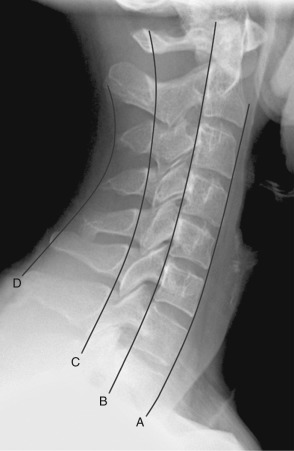Physical Address
304 North Cardinal St.
Dorchester Center, MA 02124
When it comes to spinal trauma evaluation, CT has largely replaced radiography given its higher sensitivity for detection of underlying injury. However, radiography is sometimes still obtained for initial evaluation and is widely used to monitor the treatment and healing of spinal injuries. MRI is also widely used to evaluate for presence of ligamentous and muscular injuries as well as spinal cord injuries.
Count the vertebral bodies. All seven cervical vertebral bodies and C7-T1 should be visualized.
Evaluate for presence of fractures.
Evaluate the thickness of prevertebral soft tissue. It should be less than 6-7 mm anterior to C2-C3, and its thickness should be less than 18-21 mm anterior to C6-C7. When the prevertebral soft tissue appears thickened on a lateral radiograph in the setting of acute trauma, this is suggestive of presence of prevertebral edema and/or hemorrhage related to underlying osseous or soft tissue injury.
Assess four parallel lines for alignment. From anterior to posterior, these are the anterior vertebral, posterior vertebral, spinolaminar, and posterior spinous lines ( Figure 46-1 ).

Examine the atlantoaxial interval, which is the distance between the posterior margin of the anterior arch of C1 (atlas) and the anterior margin of the odontoid process of C2 (axis). This space should not exceed 3 mm in adults and 5 mm in children. This interval should remain constant with flexion and extension in adults. Widening of this space indicates disruption of the transverse ligament of the atlas.
Compare the intervertebral disc spaces for widening or narrowing.
A swimmer's view is obtained when the lower cervical vertebrae cannot be seen on the lateral radiograph, usually because of the patient's inability to cooperate or due to a large shoulder girdle obscuring the spine in this location. This view is obtained by having the patient, in the supine position, raise his or her arm over the head while lowering the opposite arm.
This is a concept that was initially devised by Dr. Francis Denis to describe thoracolumbar spinal injuries. The anterior column of the spine is formed by the anterior longitudinal ligament, anterior annulus fibrosus, and anterior half of the vertebral bodies. The middle column of the spine is formed by the posterior longitudinal ligament, posterior annulus fibrosus, and posterior half of the vertebral bodies. The posterior column of the spine is formed by the posterior arch and interconnecting ligaments. Generally, if two or more spinal columns are involved in an injury, then the spine is considered to be unstable.
Compression fractures are caused by anterior flexion. There is anterior wedging of the affected vertebral body, with the middle vertebral column remaining intact. Because only the anterior vertebral column is affected, this fracture is usually stable. Burst fractures are caused by axial loading injuries. The fracture lines extend through the anterior and posterior cortices of the vertebral body (thus affecting both anterior and middle columns). The posterior displacement of fracture fragments can cause spinal cord injury, and these fractures are considered unstable.
The most common fracture mechanism involving the spine is hyperflexion, which includes wedge fracture, unilateral interfacet dislocation (UID), bilateral interfacet dislocation (BID), and flexion teardrop fracture. The hyperextension injuries include hangman's fracture and extension teardrop fracture.
Become a Clinical Tree membership for Full access and enjoy Unlimited articles
If you are a member. Log in here